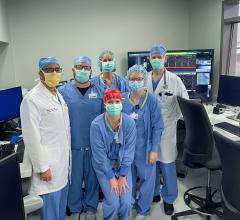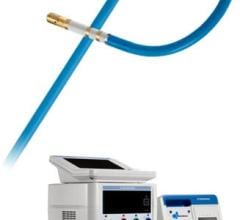June 18, 2012 — Epicardial ablation device maker Contact Inc. announced that new long-term physician data demonstrated promising clinical outcomes for the multidisciplinary convergent procedure in the treatment of persistent atrial fibrillation (AF), with more than 80 percent of patients remaining in sinus rhythm at a minimum of 12 months follow-up. The data was presented by physicians at Heart Rhythm 2012, the Heart Rhythm Society's 33rd Annual Scientific Sessions in May.
During the oral abstract sessions, a presentation by Kenneth C. Civello, M.D., Our Lady of the Lake Medical Center, Baton Rouge, La., highlighted clinical outcomes from 104 consecutive patients treated with the convergent procedure. Of these, 73 percent suffered with persistent or permanent AF. Results demonstrated that 86 percent of patients who reached six months follow-up were in sinus rhythm, with 78 percent in sinus rhythm off anti-arrhythmic drugs (AADs). Of the 40 patients who have reached 12 month follow-up, 81 percent were in sinus rhythm, with 69 percent in sinus rhythm off AADs.
A poster presented by David M. Gilligan, M.D., Levinson Heart Hospital at CJW Medical Center, Richmond, Va., reviewed data from a prospective registry of the first 39 patients to undergo ablation with the convergent procedure at the center, 79 percent of whom suffered with persistent or longstanding persistent AF. At 12 months post procedure, 96 percent of patients were in sinus rhythm with nearly 70 percent in sinus rhythm off AADs.
A poster presented by Keith M. Golden, M.D., St. Vincent Hospital, Indianapolis, Ind. demonstrated positive outcomes on 60 patients undergoing the convergent procedure, considering 88 percent of patients had persistent or longstanding persistent AF. This was a difficult cohort of patients with enlarged left atria, and an average BMI over 35. At an average follow up of 11 months (333 +/- 156 days), 79 percent of patients were in sinus rhythm. Notably, this continued to hold true for the 14 patients who reached 18 months follow-up, with 79 percent remaining in sinus rhythm, all of whom were also off AADs.
The various posters and presentations reaffirmed the ability of the convergent procedure to achieve consistent single procedure results across hospital sites. The potential advantage of the convergent procedure is that it integrates the best practices of surgeons and electrophysiologists in a single setting, utilizing a minimally invasive, trans-diaphragmatic approach for direct access to the posterior of the left atrium without chest incisions, lung deflation or cardiac dissections. Developed by physicians and enabled by nContact's epicardial ablation technology, it has been shown to be especially appropriate for AF patients with enlarged atria and persistent or long-standing persistent stages of disease.
For more information: www.ncontactinc.com


 October 30, 2024
October 30, 2024 








